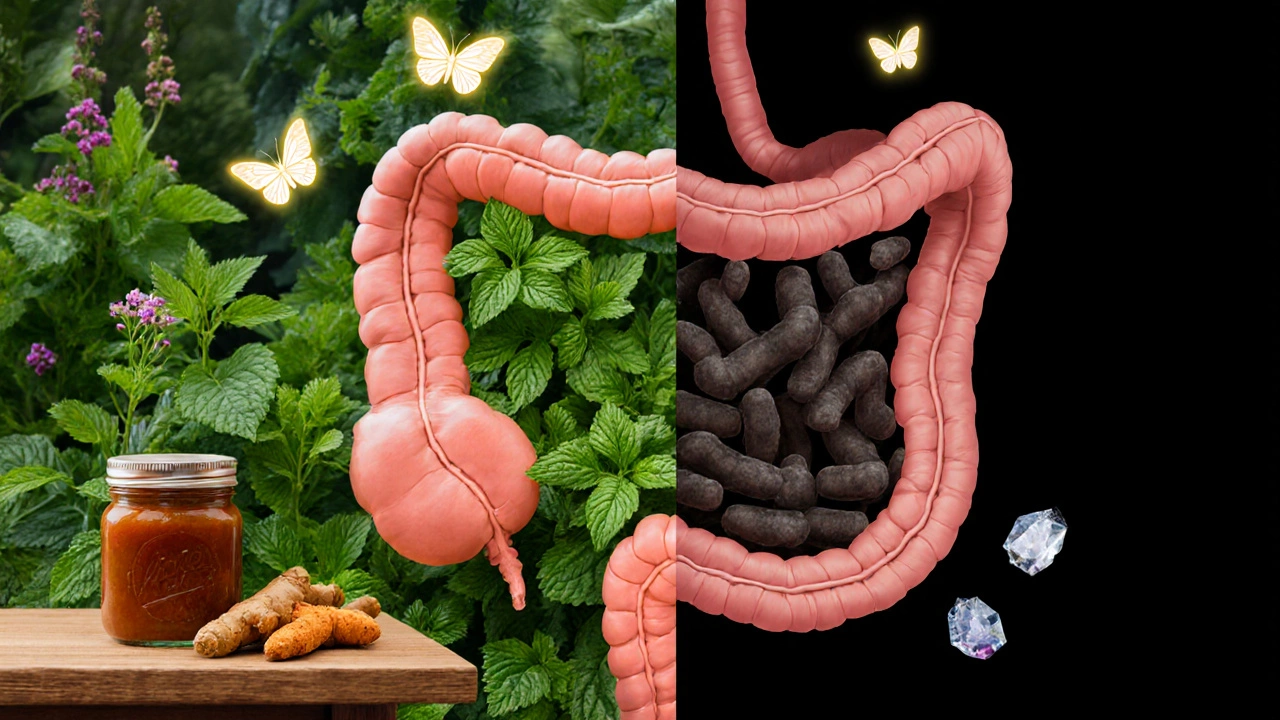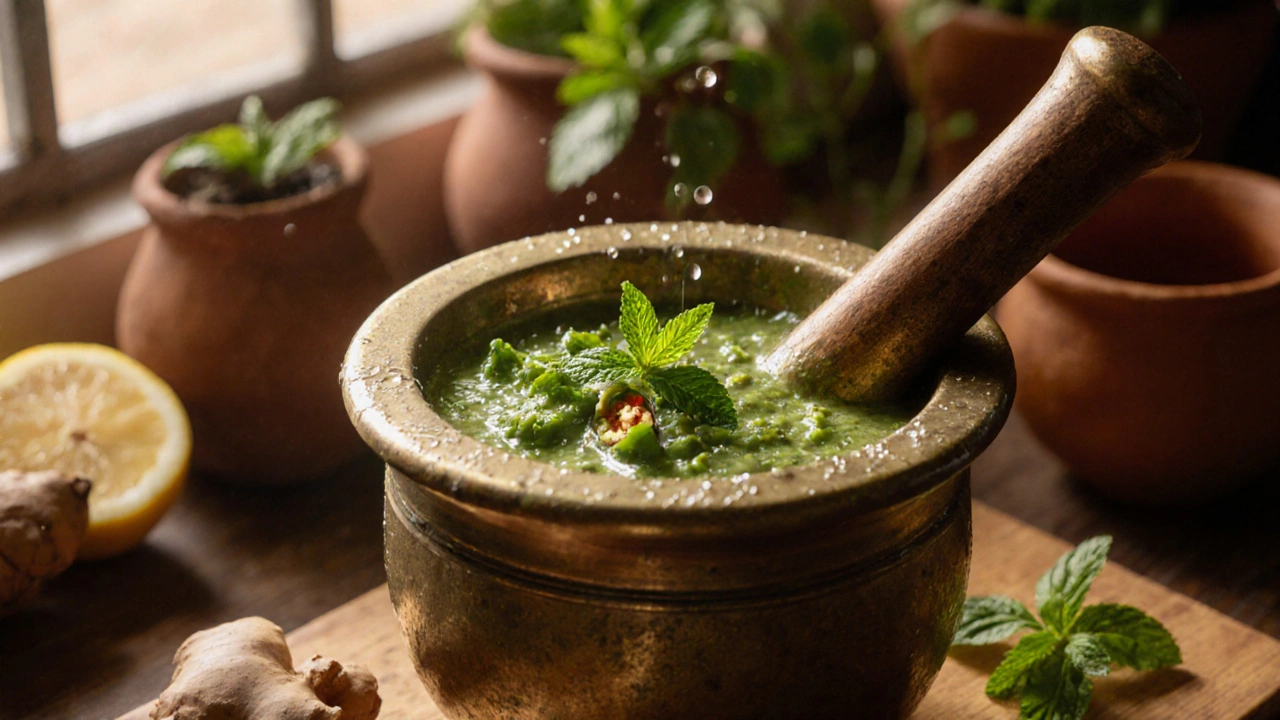Ever bitten into a spicy, tangy chutney and wondered if it’s doing more than just flavoring your dosa? You’re not alone. Millions of people in India and beyond eat chutney daily-mint with samosas, coconut with idlis, tamarind with vada-but few stop to ask: Is chutney good for your gut? The answer isn’t just yes. It’s more like, your gut might be thanking you if you eat the right kind.
What Makes Chutney Different from Other Condiments?
Most store-bought sauces are loaded with sugar, vinegar, preservatives, and artificial flavors. But traditional Indian chutneys? They’re often made with just three or four fresh ingredients: herbs, spices, fruit, or vegetables, ground together with a little salt and sometimes a splash of lemon. No additives. No long shelf life. Just real food.
Take mint chutney, for example. It’s made from fresh mint leaves, green chilies, ginger, lemon juice, and salt. No high-fructose corn syrup. No xanthan gum. Just plants you can name and recognize. That simplicity matters when you’re thinking about gut health.
The Fermentation Factor
Not all chutneys are fermented-but the ones that are, pack a powerful punch for your microbiome. Coconut chutney, for instance, is often left out at room temperature for a few hours before serving. During that time, naturally occurring bacteria on the coconut and spices begin to ferment the mixture. Same with tomato chutney made with jaggery and left to sit overnight.
Fermentation produces lactic acid bacteria-like Lactobacillus and Bifidobacterium-which are the same probiotics found in yogurt, kimchi, and sauerkraut. These good bugs help break down food, crowd out harmful microbes, and strengthen the gut lining. A 2023 study from the Indian Institute of Food Processing Technology found that homemade coconut chutney stored at room temperature for 12-24 hours showed a 40% increase in viable probiotic counts compared to freshly made batches.
That’s not magic. That’s microbiology.
Herbs and Spices: More Than Just Flavor
Chutneys aren’t just about probiotics. They’re loaded with plant compounds that calm inflammation and support digestion.
- Mint contains menthol, which relaxes intestinal muscles and reduces bloating.
- Ginger speeds up gastric emptying-meaning food moves through your stomach faster, reducing that heavy, sluggish feeling after meals.
- Turmeric (found in many tamarind chutneys) has curcumin, a compound shown in clinical trials to reduce gut inflammation in people with irritable bowel syndrome.
- Cumin stimulates bile production, helping your body digest fats more efficiently.
These aren’t vague claims. A 2022 randomized trial published in the Journal of Clinical Gastroenterology gave 120 participants with chronic bloating either a daily teaspoon of cumin powder or a placebo. After four weeks, those taking cumin reported a 50% drop in bloating and improved stool consistency.

Chutney vs. Store-Bought Sauces: The Gut Health Showdown
| Feature | Homemade Chutney | Store-Bought Ketchup/Mayo/Salsa |
|---|---|---|
| Probiotics | Yes, if fermented | No (pasteurized) |
| Sugar Content | 0-2g per tbsp | 4-12g per tbsp |
| Preservatives | None | Often: sodium benzoate, potassium sorbate |
| Anti-inflammatory Compounds | High (turmeric, ginger, mint) | Low to none |
| Fiber | 1-3g per serving (from herbs/veggies) | 0g |
That sugar difference is huge. Too much sugar feeds the bad bacteria in your gut, leading to dysbiosis-where harmful microbes overgrow and cause bloating, gas, and even cravings. Homemade chutney avoids this trap entirely.
When Chutney Might Not Help Your Gut
Not all chutneys are created equal. If you’re eating chutney from a plastic tub at the grocery store, it’s probably pasteurized. That means heat killed off any live cultures. It might taste like chutney, but it won’t act like it.
Also, if you have SIBO (small intestinal bacterial overgrowth), too much fermentable fiber from garlic, onion, or even certain fruits in chutney can worsen symptoms. In those cases, stick to simple mint or cilantro chutneys without garlic or tamarind.
And don’t forget salt. While a little salt supports digestion, overly salty chutneys can raise blood pressure and disrupt the gut microbiome over time. Aim for recipes that use less than 1/4 teaspoon per serving.
How to Make Gut-Friendly Chutney at Home
You don’t need fancy tools. A mortar and pestle or a small blender will do.
- Start with fresh ingredients: mint, coriander, coconut, tomato, tamarind, or pomegranate.
- Add a pinch of salt and a squeeze of lemon or lime. Citric acid helps preserve and encourages natural fermentation.
- For probiotic boost: leave the chutney at room temperature (covered with a cloth) for 6-12 hours before refrigerating.
- Use within 3-4 days for maximum benefit. The probiotics die off after that.
- Store in glass jars, not plastic. Plastic can leach chemicals that harm gut bacteria.
Try this simple recipe: Blend 1 cup fresh coriander, 1 green chili, 1 tsp ginger, juice of half a lemon, and a pinch of salt. Let it sit for 8 hours. Eat with dal or rice. Your gut will notice the difference.

Real People, Real Results
At a health clinic in Bangalore, nutritionist Dr. Meena Rao tracked 35 patients with chronic digestive issues who swapped store-bought sauces for homemade chutneys for six weeks. Nearly 70% reported less bloating. Over half said their stomach cramps improved. One woman, 58, said she hadn’t had a normal bowel movement in two years-until she started eating mint chutney with her lunch every day. Within three weeks, she was regular.
It’s not a miracle cure. But it’s a simple, tasty, culturally rooted habit that works.
What to Eat Chutney With
Chutney doesn’t need to be an afterthought. Pair it with foods that support digestion:
- Dal and rice: The fiber in lentils + the probiotics in chutney = a perfect gut duo.
- Whole grain roti: Adds more fiber to feed the good bacteria.
- Steamed vegetables: Chutney adds flavor and digestive enzymes.
- Plain yogurt: Double probiotic power.
Avoid pairing chutney with fried foods like samosas or pakoras. The grease slows digestion and cancels out the benefits.
Final Thought: It’s Not About Chutney Alone
Chutney isn’t a magic bullet. But it’s one of the most delicious ways to get real, whole-food probiotics and anti-inflammatory compounds into your daily meals. If you’re looking to improve your gut health, start with what’s already in your kitchen-fresh herbs, spices, and time.
Forget expensive supplements. Your best gut ally might be sitting in the fridge, waiting to be spooned onto your plate.
Is store-bought chutney good for your gut?
Most store-bought chutneys are pasteurized, which kills off probiotics. They’re also high in sugar and preservatives, which can harm gut bacteria. If you want real gut benefits, choose homemade or look for refrigerated, unpasteurized versions labeled "raw" or "fermented."
Can chutney help with bloating?
Yes, especially if it contains mint, ginger, or cumin. These ingredients relax the digestive tract and reduce gas. A 2022 study found that people who ate cumin-rich foods daily saw a 50% reduction in bloating after four weeks.
How long does homemade chutney last?
Homemade chutney lasts 3-4 days in the fridge. If you want to preserve probiotics, eat it within 24-48 hours after fermentation. After that, the beneficial bacteria start to decline. Freezing stops fermentation but doesn’t kill the probiotics-so frozen chutney still has gut benefits.
Is coconut chutney better than mint chutney for the gut?
Both are good, but for different reasons. Coconut chutney has more probiotics if fermented. Mint chutney is better for calming inflammation and easing cramps. Use both-rotating them keeps your gut microbiome diverse, which is key to long-term health.
Can kids eat chutney for gut health?
Absolutely. Start with mild versions-less chili, no garlic. Mint or cilantro chutney with a touch of lemon is great for kids. It’s a natural way to get them eating more herbs and spices instead of sugary sauces. Many Indian families introduce chutney to babies as early as 8 months, mixed into rice or dal.
